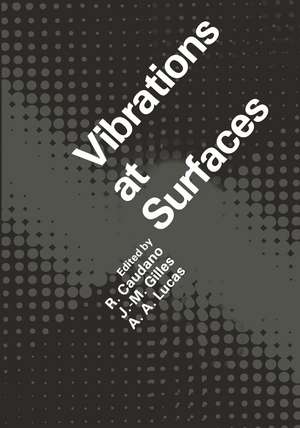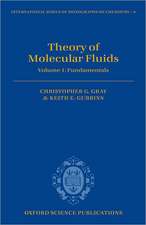Vibrations at Surfaces
Editat de R. Caudanoen Limba Engleză Paperback – 6 apr 2012
Preț: 410.46 lei
Nou
Puncte Express: 616
Preț estimativ în valută:
78.54€ • 83.99$ • 65.49£
78.54€ • 83.99$ • 65.49£
Carte tipărită la comandă
Livrare economică 18 aprilie-02 mai
Preluare comenzi: 021 569.72.76
Specificații
ISBN-13: 9781468440607
ISBN-10: 1468440608
Pagini: 600
Ilustrații: XII, 585 p.
Dimensiuni: 170 x 244 x 32 mm
Greutate: 0.94 kg
Ediția:Softcover reprint of the original 1st ed. 1982
Editura: Springer Us
Colecția Springer
Locul publicării:New York, NY, United States
ISBN-10: 1468440608
Pagini: 600
Ilustrații: XII, 585 p.
Dimensiuni: 170 x 244 x 32 mm
Greutate: 0.94 kg
Ediția:Softcover reprint of the original 1st ed. 1982
Editura: Springer Us
Colecția Springer
Locul publicării:New York, NY, United States
Public țintă
ResearchCuprins
1. Clean and Adsorbed Surfaces.- Theory of phonons on clean and adsorbed surfaces.- Desorption by resonant multiphoton excitation of internal adsorbate vibration.- Face centered cubic transition metal surface vibrations.- Atom motion at model crystal surfaces.- Infrared reflection absorption and emission study of methyl alcohol adsorption on MoO3 films.- Rotational accommodation at surfaces via Rayleigh phonons.- Arrangement of CO molecules adsorbed on low index metal surfaces: a comparison between LEED and HREELS or IRS.- Effects of many body forces on the adsorbate induced phonon structure.- Vibrational lifetimes for molecules adsorbed on metal surfaces.- Surface modes of a spherical void at the proximity of a surface.- Theoretical study of the vibrational properties of a (117)F. C. C. surface.- The chemisorption of CO on Cu: an ab initio cluster model study.- Librational modes of molecules on metals.- Vibrations of neutrally adsorbed atoms on transition metal surfaces.- 2. Electron energy loss spectroscopy.- EELS of surface phonons and vibrations of adsorbed species.- Electronic surface resonance enhancement of vibrational loss intensities.- EELS of collective surface modes.- The adsorption and co-adsorption with. CO of NO on Cu(110) studied with ELS and LEED.- The adsorption of H2O on Ru(001): chemisorption and hydrogen bonding.- On the excitation mechanism of vibrational modes of C2H4 chemisorbed on Pt(111) and Ni(111) by EELS.- Vibrations measured at metal surfaces by EELS: a review table.- High resolution electron spectroscopy: instrumentation and some results on a tungsten surface.- Theory of electron energy loss spectroscopy.- Adsorption sites of CO on the (111) face of Pt10Ni90 single crystal alloy.- 3. Infrared Spectroscopy.- A comparison of the reflection-absorption infrared method with the electron energy loss method for studying vibrations at surfaces.- Applications of IR ellipsometric spectroscopy to surface studies.- Reflection-absorption infrared spectroscopy using a Fourier transform spectrometer: a study of carbon monoxide adsorbed on Pt(111).- Collective vibrational modes in isotopic mixtures of CO adsorbed on Cu(100).- Intrinsic line widths of CO adsorbed on Cu(100).- “In situ” characterization of surface complexes of propene on oxidation catalysts (I. R. spectroscopy).- Infra-red cryospectroscopic study on the interaction of CO with a (111)Ni- and NaCl-film at low temperature under ultrahigh vacuum.- Infrared study of comparative adsorption of some alcohols and thiols on ?-alumina.- Infrared spectra of species adsorbed on films or well-defined surfaces: a tabulation of the investigated systems.- 4. Surface Enhanced Raman Scattering.- Surface enhanced Raman scattering from characterized metal surfaces.- Enhanced Raman spectroscopy from adsorbates on silver: evidence for the “Adatom Model”.- High resolution electron energy loss and surface enhanced Raman studies of pyridine and benzene on Ag(111).- Raman spectroscopy of thin organic films by integrated optical techniques.- Enhanced Raman scattering from molecules adsorbed at metal surfaces.- Enhanced Raman scattering from molecules adsorbed on resonant metal particles.- Enhanced Raman scattering from molecules adsorbed on small nickel particles.- Surface enhanced Raman scattering from different types of metal substrates.- The relevance of spatial variation in the electromagnetic vector potential for surface Raman scattering.- 5. Other Spectroscopies.- Adsorption of marked acetic acid on alumina studied by IETS.- The adsorption of unsaturated hydrocarbonson aluminium oxide and magnesium oxide: an inelastic electron tunnelling spectroscopy study.- Vibrations in benzene and toluene monolayers on the basal plane of graphite.- Photoacoustic and photothermal surface spectroscopy.- 6. Surface Molecular Dynamics and Reactivity.- Energy transfer processes in gas and surface reactions.- Electron-hole pairs, molecular vibrations, and rate processes at metal surfaces.- Static and dynamic aspects of chemisorption.- Vibrational activation and surface reactivity; SF6 interaction with silicon induced by infrared laser radiation.









